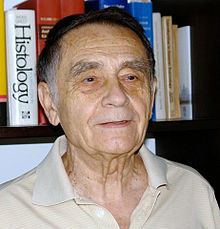- Mirosław Jan Stasik
-
Mirosław Jan Stasik (born 27 January 1929 r. in Łódź) - Polish medical doctor and toxicologist.
Contents
Education and early career
Stasik graduated from Łódź School of Medicine (now Medical University of Łódź) and later studied toxicology at the University of Surrey, United Kingdom. He obtained his Dr Med. at the Heidelberg University, Germany's oldest university.
In the 1960s he completed his training in internal medicine, and became director of the newly-created clinical department of acute poisoning at the Nofer Institute of Occupational Medicine in Łódz. There he also pioneered in the field of poison control centers in Poland.
During this period he published one of the first clinical works devoted to acute toxicity of tetraethyllead in humans.[1] This substance was commonly used as an antiknock agent in gasoline until 2005.
Further career
Since 1970 he has been living in Germany, with two breaks for training at the Institute of Toxicology of the University of Würzburg and for university study in the UK.
In Frankfurt he directed a centre of toxicology and epidemiology within the department of occupational medicine of a chemical concern Hoechst AG.
His research was focused on defining the carcinogenic potential of some aromatic amines, e.g. 3,3'-dichlorobenzidine and derivatives of aniline, as well as ethylene oxide and formaldehyde.[2]
In the 1980s Stasik represented Hoechst at scientific conferences of the Chemical Industry Institute of Toxicology (USA), as well as symposiums of the Center for Environmental Epidemiolog, University of Pittsburgh. These were organized in co-operation with the United States Environmental Protection Agency.
He was also a member of the Ecology and Toxicology Centre and the European Chemical Industry Council (CEFIC) in Brussels.
In recent years he co-operated with the Institute of Social, Occupational and Environmental Medicine at the Guttenberg University, as well as with the Department of Histology and Embryology of the Medical University of Łódź in order to continue and to publish his works on carcinogenic aromatic amines.
Main achievements
In Frankfurt, while investigating simple arylamines, Stasik discovered that 4-chloro-o-toluidine (4-COT), used as an intermediate for the manufacture of dyestuffs, pigments, and chlordimeform a pesticide, causes cancer of the urinary bladder in humans. As a direct consequence of this discovery a worldwide ban was imposed on production and use of this arylamine [3]
Professor Klaus Norpoth in his handbook of occupational medicine mentions Mirosław Stasik for the discovery of the cancer risk of 4-COT as one of 15 international researchers, who over two centuries discovered occupational carcinogenic substances, starting from Percivall Pott (1775), through Ludwig Rehn (1895), John Creech and Maurice Johnson (1974) to Stasik (1987).[4]
Stasik is an author and co-author of several dozen publications in international journals, articles in International Labour Office Encyklopedia of Occupational Health and Safety (four editions)[5] and in Ullmann's Enzyklopaedie.
Since 1997 he has been leading a branch of Societas Jablonoviana[6] in Wiesbaden. This scientific society was founded in Leipzig in 1774 by a Polish aristocrat Józef A. Jabłonowski.
4-COT Foundation
In 2001, together with his wife Dr Liliana Stasik, he set up the 4-COT Foundation[7], which sponsors studies of young Polish researchers in Western Europe and United States of America.
References
- ^ M. J. Stasik et al.: Acute Tetraethyllead Poisoning. Archives of Toxicology, 24, 283-291, 1969
- ^ M. J. Stasik, Carcinomas of urinary bladder in a 4-chloro-o-toluidine cohort, International Archives of Occupational and Environmental Health, 1988, 60 (1), 21-24
- ^ IARC Monographs Volume 99, 4-chloro-o-toluidine
- ^ M. J. Stasik, 4-chloro-o toluidyna: etiologiczny czynnik indukcji raka pęcherza moczowego, historia jednego odkrycia, Medycyna Pracy, 2003; 54 (4), str. 355-359
- ^ Jeanne Mager Stellman (edytor), Encyclopaedia of Occupational Health and Safety: Guides, indexes, directory, International Labour Office, Geneva, 1998, ISBN 92-2-109817-6
- ^ Annual conference Societas Jablonoviana, 2011
- ^ X Krajowy Zjazd Naukowy Polskiego Towarzystwa Medycyny Pracy
Categories:- Polish physicians
- People from Łódź
- Toxicologists
Wikimedia Foundation. 2010.

